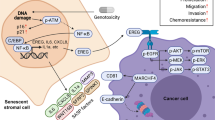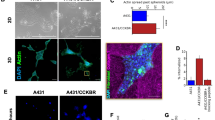Abstract
Conventional anticancer drug screening is typically performed in the absence of accessory cells of the tumor microenvironment, which can profoundly alter antitumor drug activity. To address this limitation, we developed the tumor cell–specific in vitro bioluminescence imaging (CS-BLI) assay. Tumor cells (for example, myeloma, leukemia and solid tumors) stably expressing luciferase are cultured with nonmalignant accessory cells (for example, stromal cells) for selective quantification of tumor cell viability, in presence versus absence of stromal cells or drug treatment. CS-BLI is high-throughput scalable and identifies stroma-induced chemoresistance in diverse malignancies, including imatinib resistance in leukemic cells. A stroma-induced signature in tumor cells correlates with adverse clinical prognosis and includes signatures for activated Akt, Ras, NF-κB, HIF-1α, myc, hTERT and IRF4; for biological aggressiveness; and for self-renewal. Unlike conventional screening, CS-BLI can also identify agents with increased activity against tumor cells interacting with stroma. One such compound, reversine, shows more potent activity in an orthotopic model of diffuse myeloma bone lesions than in conventional subcutaneous xenografts. Use of CS-BLI, therefore, enables refined screening of candidate anticancer agents to enrich preclinical pipelines with potential therapeutics that overcome stroma-mediated drug resistance and can act in a synthetic lethal manner in the context of tumor-stroma interactions.
This is a preview of subscription content, access via your institution
Access options
Subscribe to this journal
Receive 12 print issues and online access
$209.00 per year
only $17.42 per issue
Buy this article
- Purchase on Springer Link
- Instant access to full article PDF
Prices may be subject to local taxes which are calculated during checkout




Similar content being viewed by others
Accession codes
Change history
14 February 2024
A Correction to this paper has been published: https://doi.org/10.1038/s41591-024-02847-5
References
Mueller, M.M. & Fusenig, N.E. Friends or foes—bipolar effects of the tumour stroma in cancer. Nat. Rev. Cancer 4, 839–849 (2004).
Karnoub, A.E. et al. Mesenchymal stem cells within tumour stroma promote breast cancer metastasis. Nature 449, 557–563 (2007).
Mitsiades, C.S., Mitsiades, N., Munshi, N.C. & Anderson, K.C. Focus on multiple myeloma. Cancer Cell 6, 439–444 (2004).
Grigorieva, I., Thomas, X. & Epstein, J. The bone marrow stromal environment is a major factor in myeloma cell resistance to dexamethasone. Exp. Hematol. 26, 597–603 (1998).
Hurt, E.M. et al. Overexpression of c-maf is a frequent oncogenic event in multiple myeloma that promotes proliferation and pathological interactions with bone marrow stroma. Cancer Cell 5, 191–199 (2004).
Hideshima, T. et al. Thalidomide and its analogs overcome drug resistance of human multiple myeloma cells to conventional therapy. Blood 96, 2943–2950 (2000).
Hideshima, T. et al. The proteasome inhibitor PS-341 inhibits growth, induces apoptosis, and overcomes drug resistance in human multiple myeloma cells. Cancer Res. 61, 3071–3076 (2001).
Richardson, P.G. et al. Immunomodulatory drug CC-5013 overcomes drug resistance and is well tolerated in patients with relapsed multiple myeloma. Blood 100, 3063–3067 (2002).
Richardson, P.G. et al. A phase 2 study of bortezomib in relapsed, refractory myeloma. N. Engl. J. Med. 348, 2609–2617 (2003).
Richardson, P.G. et al. A randomized phase 2 study of lenalidomide therapy for patients with relapsed or relapsed and refractory multiple myeloma. Blood 108, 3458–3464 (2006).
Richardson, P.G. et al. Bortezomib or high-dose dexamethasone for relapsed multiple myeloma. N. Engl. J. Med. 352, 2487–2498 (2005).
Mitsiades, C.S. et al. Inhibition of the insulin-like growth factor receptor-1 tyrosine kinase activity as a therapeutic strategy for multiple myeloma, other hematologic malignancies, and solid tumors. Cancer Cell 5, 221–230 (2004).
Nefedova, Y., Cheng, P., Alsina, M., Dalton, W.S. & Gabrilovich, D.I. Involvement of Notch-1 signaling in bone marrow stroma-mediated de novo drug resistance of myeloma and other malignant lymphoid cell lines. Blood 103, 3503–3510 (2004).
Shou, Y. et al. Diverse karyotypic abnormalities of the c-myc locus associated with c-myc dysregulation and tumor progression in multiple myeloma. Proc. Natl. Acad. Sci. USA 97, 228–233 (2000).
Mitsiades, C.S. et al. Activation of NF-kappaB and upregulation of intracellular anti-apoptotic proteins via the IGF-1/Akt signaling in human multiple myeloma cells: therapeutic implications. Oncogene 21, 5673–5683 (2002).
Lee, A.H., Iwakoshi, N.N. & Glimcher, L.H. XBP-1 regulates a subset of endoplasmic reticulum resident chaperone genes in the unfolded protein response. Mol. Cell. Biol. 23, 7448–7459 (2003).
Shaffer, A.L. et al. IRF4 addiction in multiple myeloma. Nature 454, 226–231 (2008).
Mitsiades, C.S. et al. Transcriptional signature of histone deacetylase inhibition in multiple myeloma: biological and clinical implications. Proc. Natl. Acad. Sci. USA 101, 540–545 (2004).
Mitsiades, N. et al. Molecular sequelae of histone deacetylase inhibition in human malignant B cells. Blood 101, 4055–4062 (2003).
Keen, N. & Taylor, S. Aurora-kinase inhibitors as anticancer agents. Nat. Rev. Cancer 4, 927–936 (2004).
Mitsiades, N. et al. Molecular sequelae of proteasome inhibition in human multiple myeloma cells. Proc. Natl. Acad. Sci. USA 99, 14374–14379 (2002).
Opferman, J.T. et al. Development and maintenance of B and T lymphocytes requires antiapoptotic MCL-1. Nature 426, 671–676 (2003).
Yagoda, N. et al. RAS-RAF-MEK-dependent oxidative cell death involving voltage-dependent anion channels. Nature 447, 864–868 (2007).
Smith, D.R. et al. Inhibition of interleukin 8 attenuates angiogenesis in bronchogenic carcinoma. J. Exp. Med. 179, 1409–1415 (1994).
Lust, J.A. & Donovan, K.A. The role of interleukin-1 beta in the pathogenesis of multiple myeloma. Hematol. Oncol. Clin. North Am. 13, 1117–1125 (1999).
Roodman, G.D. Role of the bone marrow microenvironment in multiple myeloma. J. Bone Miner. Res. 17, 1921–1925 (2002).
Zeller, K.I., Jegga, A.G., Aronow, B.J., O′Donnell, K.A. & Dang, C.V. An integrated database of genes responsive to the Myc oncogenic transcription factor: identification of direct genomic targets. Genome Biol. 4, R69 (2003).
Yu, D., Cozma, D., Park, A. & Thomas-Tikhonenko, A. Functional validation of genes implicated in lymphomagenesis: an in vivo selection assay using a Myc-induced B-cell tumor. Ann. NY Acad. Sci. 1059, 145–159 (2005).
Lindvall, C. et al. Molecular characterization of human telomerase reverse transcriptase-immortalized human fibroblasts by gene expression profiling: activation of the epiregulin gene. Cancer Res. 63, 1743–1747 (2003).
Ingram, W.J., Wicking, C.A., Grimmond, S.M., Forrest, A.R. & Wainwright, B.J. Novel genes regulated by Sonic Hedgehog in pluripotent mesenchymal cells. Oncogene 21, 8196–8205 (2002).
Nguyen, B.C. et al. Cross-regulation between Notch and p63 in keratinocyte commitment to differentiation. Genes Dev. 20, 1028–1042 (2006).
Bhattacharya, B. et al. Gene expression in human embryonic stem cell lines: unique molecular signature. Blood 103, 2956–2964 (2004).
Kannan, K. et al. DNA microarrays identification of primary and secondary target genes regulated by p53. Oncogene 20, 2225–2234 (2001).
Shaughnessy, J.D. Jr. et al. A validated gene expression model of high-risk multiple myeloma is defined by deregulated expression of genes mapping to chromosome 1. Blood 109, 2276–2284 (2007).
Dimopoulos, M. et al. Lenalidomide plus dexamethasone for relapsed or refractory multiple myeloma. N. Engl. J. Med. 357, 2123–2132 (2007).
Weber, D.M. et al. Lenalidomide plus dexamethasone for relapsed multiple myeloma in North America. N. Engl. J. Med. 357, 2133–2142 (2007).
San Miguel, J.F. et al. Bortezomib plus melphalan and prednisone for initial treatment of multiple myeloma. N. Engl. J. Med. 359, 906–917 (2008).
Mitsiades, C.S. et al. Fluorescence imaging of multiple myeloma cells in a clinically relevant SCID/NOD in vivo model: biologic and clinical implications. Cancer Res. 63, 6689–6696 (2003).
Acknowledgements
Supported by the Dunkin Donuts Rising Stars program at the Dana-Farber Cancer Institute (C.S.M.), the Chambers Medical Foundation (C.S.M. and P.G.R.), the Steven Cobb Foundation (D.W.M., C.S.M.) and US National Institutes of Health grant R01CA050947 (C.S.M. and K.C.A.). We wish to thank T. Libermann and M. Joseph-Bruno (Harvard Institutes of Medicine Genomics Core) for generation of gene expression data and L. Buon for help with bioinformatic analyses.
Author information
Authors and Affiliations
Contributions
D.W.M. conducted experiments, performed analysis and wrote the manuscript; J.D. conducted experiments, performed analysis; E.W. conducted experiments, performed analysis; J.M.N. conducted experiments, performed analysis; D.C.G. conducted experiments, performed analysis; S.K. generated cell lines; N.M. performed analysis; R.L.S. provided primary tissue samples; N.C.M. provided primary tissue samples; A.L.K. performed analysis and participated in writing the manuscript; J.D.G. provided cell lines; P.G.R. provided primary tissue samples; K.C.A. participated in writing the manuscript; C.S.M. performed analysis, wrote manuscript and supervised the project.
Corresponding author
Ethics declarations
Competing interests
D.W.M. has equity in Axios Biosciences. R.L.S. is on the Speakers Bureau for Millennium and Celgene. K.C.A. is a consultant for Millennium, Celgene and Novartis. C.S.M. has received in the past consultant honoraria from Millennium, Novartis, Bristol-Myers Squibb, Merck, Kosan, Pharmion and Centocor, as well as licensing royalties from PharmaMar. He has also received research funding from Amgen, AVEO Pharma, EMD Serono, Sunesis and Gloucester Pharmaceuticals.
Supplementary information
Supplementary Text and Figures
Supplementary Methods, Supplementary Figures 1–8 and Supplementary Tables 1–2 (PDF 2099 kb)
Rights and permissions
About this article
Cite this article
McMillin, D., Delmore, J., Weisberg, E. et al. Tumor cell-specific bioluminescence platform to identify stroma-induced changes to anticancer drug activity. Nat Med 16, 483–489 (2010). https://doi.org/10.1038/nm.2112
Received:
Accepted:
Published:
Issue Date:
DOI: https://doi.org/10.1038/nm.2112
This article is cited by
-
Genome-scale functional genomics identify genes preferentially essential for multiple myeloma cells compared to other neoplasias
Nature Cancer (2023)
-
Multiple functions of reversine on the biological characteristics of sheep fibroblasts
Scientific Reports (2021)
-
Genome-scale screens identify factors regulating tumor cell responses to natural killer cells
Nature Genetics (2021)
-
Modeling neoplastic disease with spheroids and organoids
Journal of Hematology & Oncology (2020)
-
Ectopic expression of BIRC5-targeting miR-101-3p overcomes bone marrow stroma-mediated drug resistance in multiple myeloma cells
BMC Cancer (2019)



